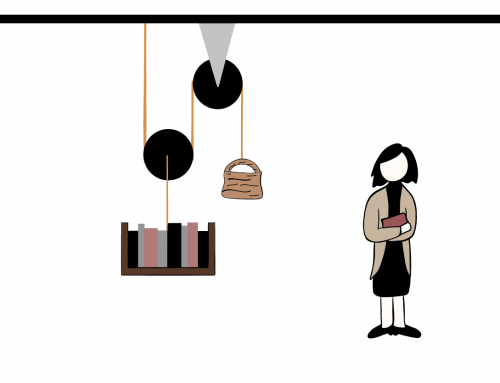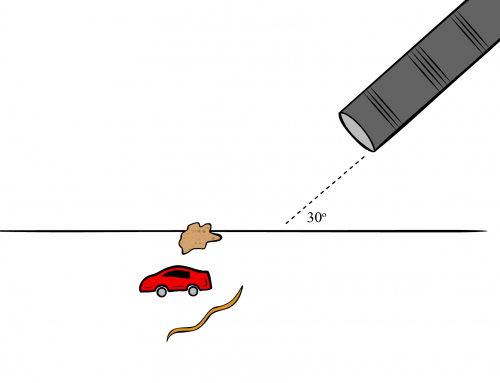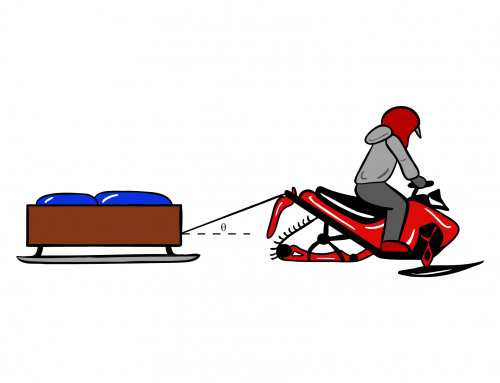An unfortunate crew member has taken a tumble over the side of the ship, and the captain is trying to pull them up using an ideal rope. Ocean waves continue to rock the boat and the ship’s bow is tipped at an angle 10º. The captain thanks her lucky stars that her shoes have reinforced soles that should supply sufficient traction to keep from sliding off the boat. If the captain’s mass is 55 kg, and the mass of the sailor is 70 kg, what must be the coefficient of static friction between the deck and the captain’s shoes just before she begins to slide? Assume any friction between the rope and the ship’s handles is negligible.
Draw a free body diagram; the free body diagram will have a diagonal normal force and a diagonal force due to friction, but a horizontal tension. Be careful with the angle. You may consider rotating the coordinate axes.
For the sailor, Newton’s Second Law is:
\begin{equation*}
T = m_s g.
\end{equation*}
Newton’s Second Law in the \({x-}\)direction for the captain is:
\begin{equation*}
T – fr_{max} \cos \theta – N \sin \theta = 0,
\end{equation*}
where \(fr_{max}=\mu N\). Replacing the tension \(T\), and then solving for \(N\) we get:
\begin{equation*}
N = \frac{m_s g}{\mu \cos \theta + \sin \theta}.
\end{equation*}
Newton’s Second Law in the \({y-}\)direction for the captain is:
\begin{equation*}
N \cos \theta – fr_{max} \sin \theta – m_c g = 0.
\end{equation*}
Replacing the normal force \(N\) in the last equation, and solving for \(\mu\) with some algebra, we get:
\begin{equation*}
\mu = \frac{m_s \cos \theta – m_c \sin \theta}{m_c \cos \theta + m_s \sin \theta},
\end{equation*}
and plugging in numerical values:
\begin{equation*}
\mu = 0.895.
\end{equation*}
For a more detailed explanation of any of these steps, click on “Detailed Solution”.
Let’s use a system of coordinates where the X-axis is horizontal, and the Y-axis is vertical, as illustrated in figure 1.
Figure 1: We choose a coordinate system with the Y axis pointing upwards and the positive X axis to the right.
Let’s then study the forces on the captain. Due to the weight of the sailor, the rope will exert a tension on the captain’s hand that points in the positive X-axis. As the captain uses her strength to hold the rope, her shoes will tend to slide over the ship’s floor. Thus, the ship’s surface will exert a static friction force that prevents the shoes from sliding. Since the floor is not perfectly horizontal but rather has a slope, the static friction will have an X-component and a Y-component, illustrated in the diagram below. Finally, there are two more forces acting on the captain, the weight, which points in the negative Y direction, and the normal force, which is perpendicular to the floor. Again, since the floor is not perfectly horizontal, this normal force will have an X and a Y component. Hence, the force diagram for the captain can be seen in figure 2.
Figure 2: Force diagram for the captain. The forces exerted on the captain are: the contact force with the floor \(N\), the tension of the rope \(T\), and the weight \(W_c\).
We also have to study the forces over the sailor, since the sailor is affecting the captain (for example, the tension the rope makes over the captain’s hand critically depends on the mass of the sailor). The force diagram over the sailor is, thankfully, very simple. There are only two forces, the tension, pointing upwards (in the positive Y direction), and the weight, pointing downwards. Hence, the force diagram for the sailor is shown in figure 3.
Figure 3: Force diagram for the sailor. The forces exerted on the sailor are the tension on the rope \(T\) and the weight \(W\).
Now, in general, there is no single equation for the static friction force because this force depends on the other external forces acting on the object. For example, the greater the mass of the sailor, the stronger the rope will pull the captain’s hands, and so the greater the static friction between the shoes and the floor must be so that the shoes do not slide. But for the case where the object in question is about to slide (such as this case) the static friction must be maximum, and there is a known equation for its magnitude, namely,
\begin{equation}
\label{RescueBoat_friccion}
fr_{max}=\mu N,
\end{equation}
where \(\mu\) is the coefficient of static friction and \(N\) is the magnitude of the normal force that the floor exerts on the captain’s shoes. From this equation, it is clear that in order to find the minimum coefficient of static friction between the shoes and the floor, we need to find both the normal force \( N \) and the friction force \(fr_{max}\). To find the latter, let’s write Newton’s Second Law for the captain along X, taking into account the force diagram drawn earlier. The tension the rope exerts on the captain’s hands points in the direction of the positive X-axis, the static friction and the normal force have an X component that opposes this motion along the negative X axis. So, in X, we have
\begin{equation}
\label{RescueBoat_fuerzasXCapitan}
T \, \hat{\textbf{i}} – fr_{{max}_x} \, \hat{\textbf{i}} – N_x \, \hat{\textbf{i}} = m a_x \, \hat{\textbf{i}},
\end{equation}
where \(fr_{{max}_x}\) and \(N_x\) are the X components of the friction force and the normal force along X, respectively. Now, for the case where the captain is about to slide, the acceleration is zero (the captain is not yet sliding), and so the previous equation yields
\begin{equation}
\label{RescueBoat_fuerzasXCapitanAcCero}
T \, \hat{\textbf{i}} – fr_{{max}_x} \, \hat{\textbf{i}} – N_x \, \hat{\textbf{i}} = 0 \, \hat{\textbf{i}}.
\end{equation}
If we focus on the magnitudes and rearrange the terms, we get
\begin{equation}
\label{RescueBoat_tension}
T = fr_{{max}_x} + N_x.
\end{equation}
In order to use this equation with equation \eqref{RescueBoat_friccion}, we need to find the tension, and we also have to relate \(fr_{{max}_x}\) to \(fr_{{max}}\). From the force diagram, one sees that
\begin{equation}
fr_{{max}_x}=fr_{{max}} \cos \theta,
\end{equation}
and also that
\begin{equation}
N_x=N \sin \theta,
\end{equation}
where \(\theta\) is the slope of the floor (which we know). If we use these results in equation \eqref{RescueBoat_tension}, we then get
\begin{equation}
\label{RescueBoat_tensionDespejada}
T = {(fr_{{max}} \cos \theta)} + {(N \sin \theta)}.
\end{equation}
Recall that we want to find \(fr_{{max}}\) to use it with equation \eqref{RescueBoat_friccion}, and so we now need to find the tension. In order to do that, let’s study the forces over the sailor. As we indicated in the force diagram, there are only two forces over the sailor, the tension that points upward and the weight, pointing in the negative Y-direction. So Newton’s Second Law gives
\begin{equation}
T_y \, \hat{\textbf{j}} – W \, \hat{\textbf{j}} = m a_y \, \hat{\textbf{j}},
\end{equation}
where \(T_y\) is the magnitude of the tension over the sailor’s hand, and \(a_y\) the vertical acceleration. But notice that the rope is ideal, and it is stretched. This means that the magnitude of the tension produced by the two endpoints is the same, and also that the magnitude of the acceleration of the two objects attached to the string is the same (for an ideal rope that is stretched, these two things are always true). Hence, \(T_y\) equals \(T\), and \(a_y\) must be equal to zero (since the acceleration of the captain is zero). So we get
\begin{equation}
{(T)} \, \hat{\textbf{j}} – W \, \hat{\textbf{j}} = 0 \, \hat{\textbf{j}}
\end{equation}
Using that \(W = m_s g\), rearranging the terms, and focusing on the magnitudes only, we get
\begin{equation}
T ={(m_s g)}.
\end{equation}
We can use this result in equation \eqref{RescueBoat_tensionDespejada}. We get
\begin{equation}
{(m_s g)} = fr_{{max}} \cos \theta + N \sin \theta.
\end{equation}
From here, we can finally use equation \eqref{RescueBoat_friccion} to get
\begin{equation}
m_s g = {(\mu N)} \cos \theta + N \sin \theta,
\end{equation}
and rewrite this equation as
\begin{equation}
m_s g = (\mu \cos \theta + \sin \theta)N,
\end{equation}
to get an expression of the normal force
\begin{equation}
\label{RescueBoat_normalParaReemplazar}
N = \frac{m_s g}{\mu \cos \theta + \sin \theta}.
\end{equation}
The only variable that we do not know yet from this equation is \(N\). To find it, consider the equations along Y over the captain. As we showed in the diagram, there are three forces: the Y component of N, the Y component of \(fr_{max}\), and the weight:
\begin{equation}
N_y \, \hat{\textbf{j}} – fr_{max_{y}} \, \hat{\textbf{j}} – W_c \, \hat{\textbf{j}} = m a_y \, \hat{\textbf{j}}.
\end{equation}
But the captain is not accelerating, and so \(a_y\) is zero. Furthermore, the weight is given by \(m_c g\), so we get
\begin{equation}
N_y \, \hat{\textbf{j}} – fr_{max_{y}} \, \hat{\textbf{j}} – {(m_c g)} \, \hat{\textbf{j}} = 0 \, \hat{\textbf{j}}.
\end{equation}
If we rearrange terms and focus on the magnitudes we get
\begin{equation}
N_y = fr_{max_{y}} + m_c g.
\end{equation}
Now, notice from the force diagram that \(N_y = N \cos \theta \) and \(fr_{max_{y}} = fr_{max} \sin \theta \). Hence, we get
\begin{equation}
{(N \cos \theta)} – {(fr_{max} \sin \theta)} = m_c g.
\end{equation}
We can use equation \eqref{RescueBoat_friccion} again to get
\begin{equation}
N \cos \theta – {(\mu N)} \sin \theta = m_c g,
\end{equation}
and factorize the normal force \(N\) to get
\begin{equation}
N (\cos \theta – \mu \sin \theta) = m_c g.
\end{equation}
Finally, we can use this in equation \eqref{RescueBoat_normalParaReemplazar} to get
\begin{equation}
{\left( \frac{m_s g}{\mu \cos \theta + \sin \theta} \right)}(\cos \theta – \mu \sin \theta) = m_c g.
\end{equation}
We can then multiply by \((\mu \cos \theta + \sin \theta) \) at both sides:
\begin{equation}
(m_s g) (\cos \theta – \mu \sin \theta) = (m_c g) (\mu \cos \theta + \sin \theta).
\end{equation}
If we distribute those factors, we get
\begin{equation}
m_s g \cos \theta – m_s g \mu \sin \theta = m_c g \mu \cos \theta + m_c g \sin \theta,
\end{equation}
where we can cancel out the gravity \(g\) since it is found in every term. If we rearrange and factorize \(\mu\), we get
\begin{equation}
m_s \cos \theta – m_c \sin \theta = \mu (m_c \cos \theta + m_s \sin \theta ).
\end{equation}
If we divide by \( (m_c \cos \theta + m_s \sin \theta ) \) at both sides, we can finally obtain an expression for \( \mu \):
\begin{equation}
\frac{m_s \cos \theta – m_c \sin \theta}{m_c \cos \theta + m_s \sin \theta} = \mu
\end{equation}
Let’s insert the numerical values here:
\begin{equation}
\mu = \frac{(70\,\text{kg}) \cos (10^\circ) – (55\,\text{kg}) \sin (10^\circ)}{(55\,\text{kg}) \cos (10^\circ) + (70\,\text{kg}) \sin (10^\circ)},
\end{equation}
to get
\begin{equation}
\mu = 0.895.
\end{equation}
You need to be registered and logged in to take this quiz. Log in






Leave A Comment